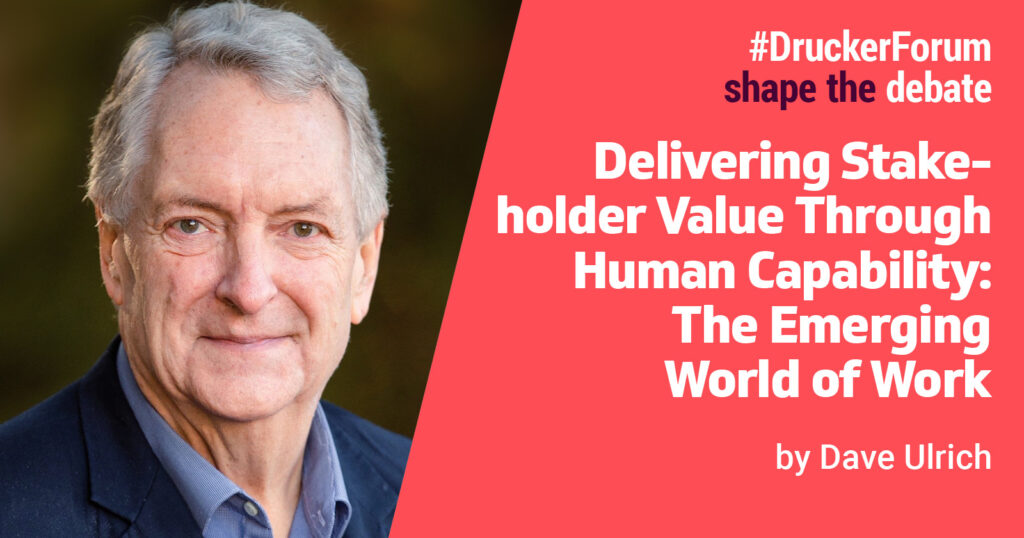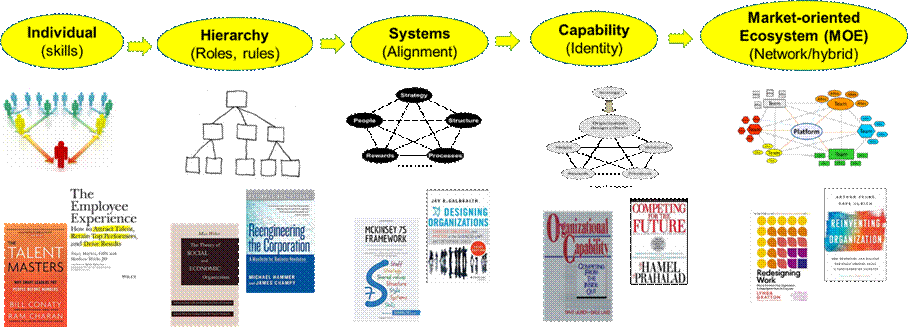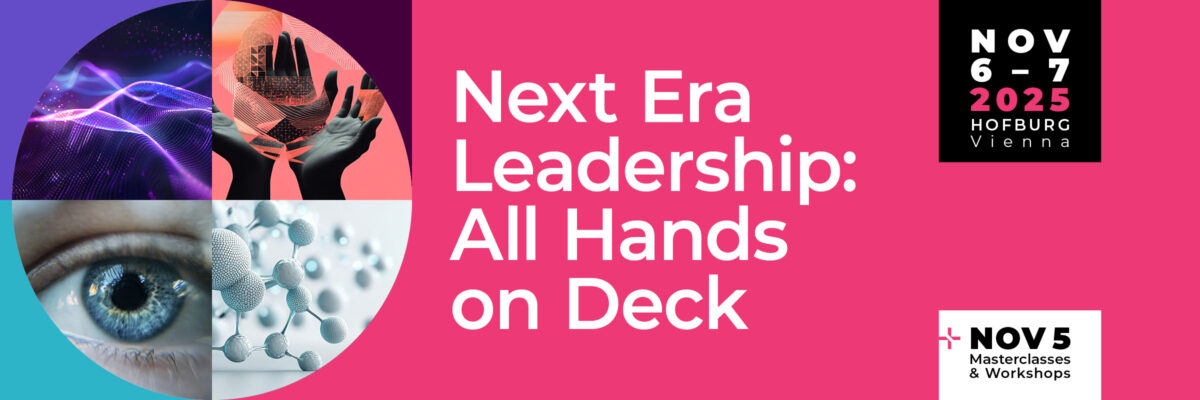
Everyone recognizes the rapidly evolving world of work with social, technology, economic, political, environmental, and demographic (STEPED) disruptions. While it might have been possible before to focus on customer or strategy or technology or culture or people or leadership or new HR operating models, today’s complex and rapidly changing business context requires alignment, integration, and simplicity in the face of complexity. Let me suggest three simple (not easy!) principles shaping the new world of work.
First, start outside/in. If an organization does not succeed in the marketplace, there is no workplace. This outside/in logic is not new; many apparently “high performing” organizations have failed because they missed market evolutions (e.g, Nokia, Blockbuster, Kodak, Toys-R-Us, Borders, Compaq). In today’s work, effective internal practices start by aligning to the external ecosystem in which they operate. This means recognizing the value for each external stakeholder (customer, investor, community, etc). The outside/in logic redefines the “human” in traditional “human resource” logic. “Humans” are all individuals who engage with the organization to receive value, not just employees. Figure 1 shows the value that human capability might provide for key stakeholders (who are human).
Figure 1: Human Capability Value for All Stakeholders

Second, there are innumerable initiatives related to possible internal organization initiatives or actions – as evidenced by the number of conferences, podcasts, webinars, research reports, and LinkedIn posts.
To become a sustainable science, every discipline uses systematics (classification of separate items into common groups) to create taxonomies (types of things that go together) to make progress, as in Figure 2).
Figure 2: Disciplines Using Taxonomies
| Discipline | Taxonomy and Frameworks Used |
| Biology | Types of living organisms (domain, kingdom, phylum, class, order, family, genus, species) |
| Information Systems | Types of components (hardware, software, databases, networks); Types of information uses (transactions, decision support, enterprise resource planning (ERP)) |
| Medicine or Health Care | Types of diseases, procedures, medications, and services that enable information retrieval, research, and patient care |
| Sociology | Groups by social stratification (economic, social class, occupation); Demographics (race, gender, education) |
| Psychology | Big five personality types, psychological disorders (DSM III); Types of therapy (cognitive, psychodynamic, behavioural) |
| Political science | Types of political systems (democracy, monarchy, totalitarianism); Ideologies (liberal, conservative) |
| Business | Types of risk (compliance, operations, operational, financial); Customer segmentation, income statement reporting (GAAP) |
In the people and organization space, now is the time for an integrated framework to organize and categorize the myriads of initiatives. A human capability taxonomy will standardize language and fundamental ideas, simplify complexity, facilitate decision-making, cumulate insights, improve reporting, and inform action.
As people and organization issues are discussed with employees, executives, boards, investors, customers, and regulators, an integrated framework allows for clearer communication about what is happening (benchmarking) and what should happen in a particular situation (guidance).
We believe, and research has shown, that a human capability taxonomy organizes and advances stakeholder value (figure 3).
Figure 3: Human Capability Taxonomy:
Talent + Leadership + Organization + HR Function

Talent (called workforce, people, labor) focuses on attracting, developing, incentivizing, engaging, and ensuring that individuals have the competencies (knowledge, skills, attitudes) required to deliver stakeholder value. Organizations seek to become the employer of choice of employees customers would choose and investors pay for.
Organizations (called workplace culture, systems) turn individual competencies into organization capabilities that deliver value to employees inside and customers, investors, and communities outside. Thinking about organizations has evolved (Figure 4) to focus on organizations as bundles of capabilities in a market-oriented ecosystem.
Figure 4: Evolution of Organization Logic

Leaders as individuals matter, as evidenced by more than 5bn Google hits on the query “leader.” Every individual can identify a mentor, coach, parent, boss, or other leader who influenced how they think, act, and feel. With so many studies of how to be an effective leader, the logic of taxonomy again becomes helpful.
Twenty years ago, we approached 15 thought leaders on leadership with two questions: [1] What percent of leadership is the same basic skill set? And [2] what are those key skills regardless of country, industry, firm size, or level of leader? These thought leaders had published over 100 books and conducted more than 3m 360-degree reviews. On question 1, their answers were 65–75% of leadership competencies are the same basic skills, while for question 2, these skills clustered into what we called the Leadership Code (Figure 5).
Over the last 20 years, we have found that leadership (leaders at all levels) operate on these five timeless principles, but with timely focus on immediate issues depending on the context.
Figure 5:
Leadership Code: Five Timeless Domains of Leadership

The HR function is now less about HR and more about delivering value to all stakeholders through human capability (talent, organization, and leadership). The HR function should be a business within the business operating like a professional services firm with agility, abilities, and accountabilities.
As the third principle shaping today’s work, using a stakeholder-value lens through the four human capability domains, a timely next challenge is to use HR agents, genAI, and analytics to both improve all human capability initiatives and to prioritize which of those initiatives deliver the most stakeholder value. Today, “talent” would include not only full- and part-time employees and contractors, but also AI agents able to accomplish work tasks. AI tools can diagnose which organization capabilities (agility, innovation, customer-centricity, strategic unity, efficiency, etc) have the most impact on stakeholder value. And AI can provide leaders information to improve their ability to be strategists, executors, talent managers, human capital developers, and be seen as personally proficient.
Conclusion: Stakeholder value through human capability converges what happens inside to value created outside, and of integrated human-capability (talent + leadership + organization + HR) solutions informed and multiplied by AI and analytics. This approach offers business leaders exciting opportunities for redefining the world of work.
About the author:
Dave Ulrich has been the Rensis Likert Professor at the Ross School of Business, University of Michigan and a partner at the RBL Group (http://www.rbl.net). He has published over 200 articles and book chapters and over 30 books. He edited Human Resource Management for ten years, served on editorial board of four other journals and on the Board of Directors for Herman Miller (16 years), has spoken to large audiences in 90 countries; performed workshops for over half of the Fortune 200; coached successful business leaders, and is a Distinguished Fellow in the National Academy of Human Resources. He posts weekly and comments daily on LinkedIn (over 350,000 followers and 3,300,000 page views in 2024) and has a free weekly newsletter with over 220,000 subscribers (https://lnkd.in/gbRqJHkW). His work creates ideas with impact about how to deliver stakeholder value through human capability (talent + organization + leadership + HR).

